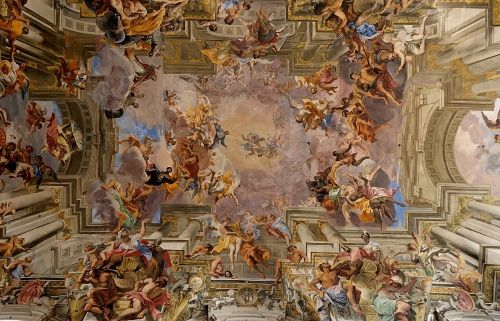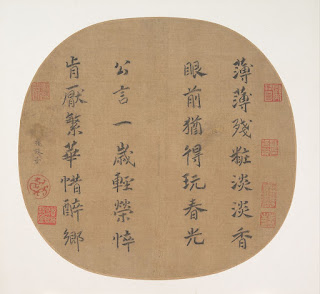Baroque Art: The Triumph of the Name of Jesus
The Apotheosis of St Ignatius (1685-94)
Artist: Andrea Pozzo (1642-1709)
Medium: Fresco painting
Genre: Religious history painting
Movement: Baroque art
Location: Church of St. Ignatius of Loyola, Campus Martius, Rome
I chose the religious history painting The Apotheosis of St Ignatius (1685-94) by Andrea Pozzo because it was so chaotic and crisp.
Andrea Pozzo, entered a monastery in 1665. He studied painting in Milan, Genoa, and Venice and was invited by P. Oliva, general of the Jesuit order, to come to Rome where he arrived in 1681. He would express that the viewer in the nave looking up would see a lofty dome when in actuality the church's ceiling was flat. A metal disk was placed on the floor of the nave, marking the spot where the viewer should stand to see the work with full effect, as the artist said, "To deceive the eyes, a certain fixed point" is needed. The connections between the art piece from Pozzo and the Baroque era was the major influences such as the Council of Trent. Which thought that the arts should communicate religious themes in direct and emotional involvement, was highly encouraged by the Roman Catholic Church. (New World Encyclopedia).
"This mural painting depicts the triumph of St. Ignatius, founder of the Jesuits, shown left of center in his grey cassock extending toward Christ, who holds a cross in the middle. All the light in the fresco comes from Christ, emphasized both by the golden swirling center and the gradually darkening color palette in the figures at a greater distance. The ray then breaks into four diagonal rays, representing the light of Christianity reaching the four continents of the world, and symbolizes the missionary work of the Jesuits. Also depicted are many Biblical warriors with their foes including David and Goliath, Jael and Sisera, Samson and the Philistines, and Judith and Holofernes. This innovative choice of subject matter reflected the militant Catholicism of the Counter-Reformation and the apostolic zeal of the Jesuits, seeing themselves as "warriors" for the faith." (Architecture, Baroque)
I really enjoyed the use of rich colors and the overall illusion he created with a flat surface. He really led the way for future trends, a trail of work followed with the same techniques. I can relate to this, because it gives off so many emotions, if I had this talent, I would have it inside my home.
Architecture, Baroque. "Baroque Art And Architecture Movement Overview". The Art Story, 2022, https://www.theartstory.org/movement/baroque-art-and-architecture/.
"Baroque Period - New World Encyclopedia". Newworldencyclopedia.Org, 2021, https://www.newworldencyclopedia.org/entry/Baroque_period.




It's crazy how a painting of this scale is done by one person. The illusion of domed ceilings created by artists during the Baroque era is interesting because it kind of echos the Renaissance era's tradition of paintings on ceilings that actually had domes. It almost feels like an ode to the previous centuries art inclinations and follows the trend of history repeating itself in terms of new eras being reminiscent of the ones that came before them. Much like the Italian/Northern Renaissance was heavily influenced by ancient Roman and Greek civilizations and their mythology.
ReplyDelete